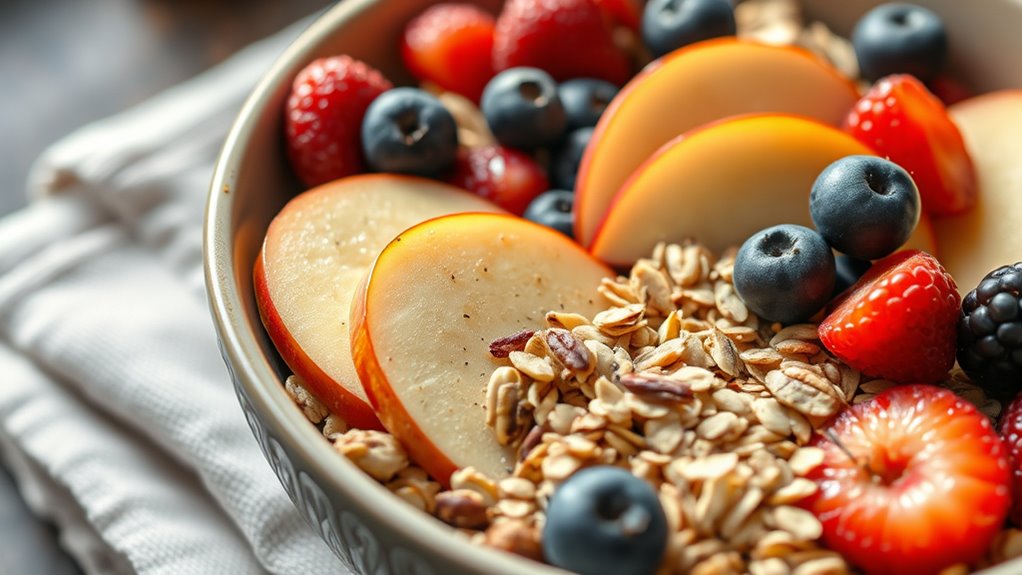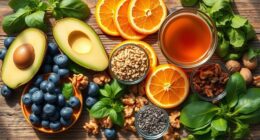Fiber quietly supports your weight control efforts by boosting feelings of fullness, stabilizing blood sugar, and reducing cravings. It helps you stay satisfied longer and cuts down on overeating, making it easier to stick with healthy habits. Incorporating fiber-rich foods like fruits, vegetables, and whole grains can improve digestion, mood, and overall health. Want to discover practical ways to harness fiber’s power? Keep exploring how this simple nutrient can transform your wellness journey.
Key Takeaways
- Dietary fiber promotes satiety and fullness, helping reduce overall calorie intake for weight control.
- Soluble fibers slow digestion and blood sugar spikes, supporting steady energy levels and appetite regulation.
- High-fiber foods displace higher-calorie options, aiding weight loss without restricting calories.
- Increasing fiber intake improves gut health and hormone regulation, which can suppress hunger and cravings.
- A fiber-rich diet enhances metabolic efficiency and reduces risks of weight-related chronic diseases.
The Link Between Dietary Fiber and Weight Loss

Research shows that increasing your dietary fiber intake can considerably support weight loss, even if your overall macronutrient and calorie intake remain unchanged. Higher fiber consumption is a strong predictor of weight loss, especially when paired with reduced calorie intake. Viscous fibers are particularly effective at suppressing appetite and helping you feel full longer. When you eat fiber-rich foods like fruits, vegetables, beans, grains, and nuts, you’re not only improving your health but also enhancing your ability to shed pounds. Fiber increases feelings of satiation by slowing digestion and influencing hunger hormones. It also supports gut health and influences nutrient absorption, which can stabilize blood sugar levels. Understanding the role of digestive processes can help you better appreciate how fiber impacts weight management. Overall, raising your fiber intake is a simple yet powerful way to promote weight loss.
How Fiber Enhances Dietary Adherence and Satisfaction
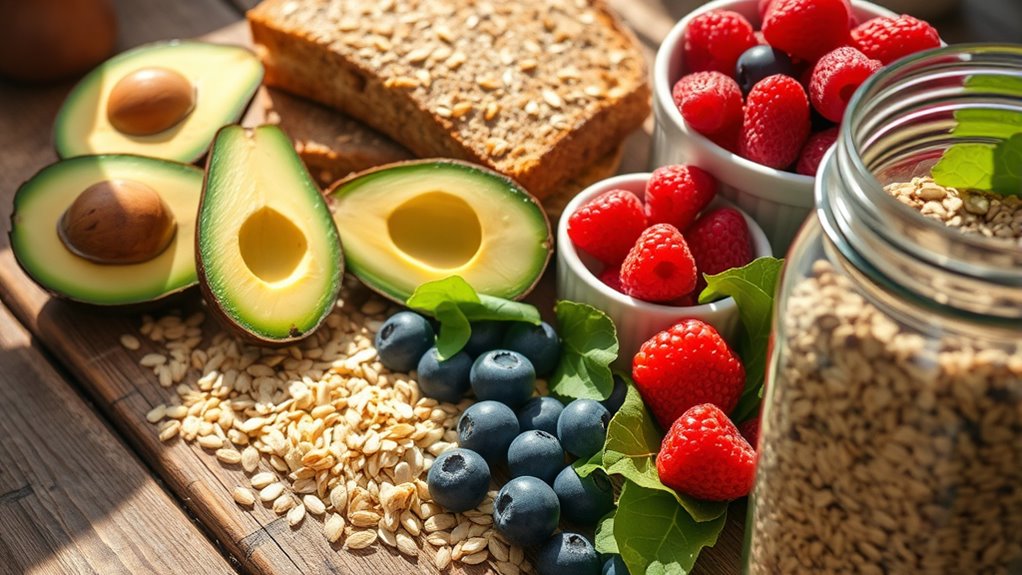
Incorporating more fiber into your diet not only promotes weight loss but also makes sticking to your eating plan more manageable and enjoyable. High-fiber diets help you feel fuller longer, reducing hunger and cravings, which supports consistent calorie control. When your meals include beans, fruits, vegetables, or whole grains, they become more satisfying and acceptable, encouraging long-term adherence—often up to six months. Meeting or exceeding 25 grams of fiber daily helps maintain a hypocaloric diet without increased dropout rates. Fiber also adds variety to your meals through different textures and flavors, making eating more pleasurable. Plus, it stabilizes blood sugar levels, which minimizes cravings and keeps your mood positive, reinforcing your motivation to stay on track. Incorporating seeds like chia can also boost your nutrient intake, particularly omega-3 fatty acids and fiber, further supporting overall health and satiety. A diet rich in fiber can also promote digestive health, making it easier to follow your nutritional goals. Additionally, the soluble fiber in chia seeds absorbs water and forms a gel-like substance that can help with hydration and digestive comfort. Recognizing the importance of fiber variety in your meals ensures a more sustainable and enjoyable dietary routine. Understanding how to incorporate fiber effectively into your daily meals can enhance both your health and weight management efforts.
Balancing Macronutrients With Fiber for Optimal Results
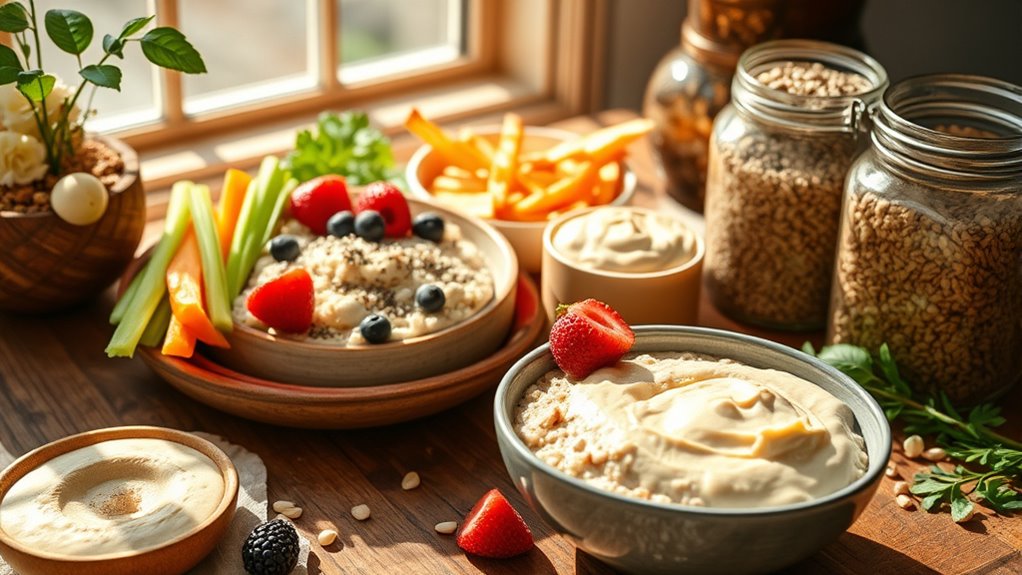
Balancing your macronutrients with fiber can boost your weight control efforts by improving meal composition and nutrient intake. When you include fiber-rich foods across different macronutrient groups, you support better digestion, satiety, and energy regulation. Focusing on the right mix helps you achieve more consistent results and sustainable progress. Incorporating fiber-rich foods into your diet can further enhance these benefits by promoting metabolic health and preventing overeating. Additionally, wall organization systems can help create a clutter-free environment that reduces stress and promotes mindful eating, indirectly supporting healthier habits.
Enhancing Nutrient Balance
Integrating fiber into your macronutrient plan can considerably improve your weight management efforts. It helps balance carbs by slowing digestion and blood sugar spikes, supports satiety with protein, and reduces fat absorption for calorie control. Combining fiber-rich foods with balanced macronutrients optimizes nutrient absorption and utilization. Monitoring dietary quality is essential to ensure you’re achieving your health goals effectively. Aim for around 25 grams of fiber daily, mainly from fruits, vegetables, beans, grains, and nuts. This synergy not only enhances nutrient intake but also promotes better dietary adherence, essential for long-term results. Regularly assessing and adjusting your fiber intake can further support your health goals by preventing clutter buildup in your diet and lifestyle.
Optimizing Meal Composition
Optimizing meal composition involves carefully combining macronutrients with fiber-rich foods to achieve better weight management results. When you include high-fiber foods like fruits, vegetables, and whole grains, you naturally reduce energy density, helping you feel full longer. This satiety can lead to decreased calorie intake without feeling deprived. Balancing macronutrients—carbohydrates, proteins, and fats—with fiber enhances metabolic health and supports weight loss. For example, pairing high-protein foods with fiber-rich options boosts satiety and promotes fat burning. Incorporating a variety of fiber sources ensures your diet remains nutritious and satisfying. Utilizing the principles of contrast ratio and image quality can be metaphorically applied to create a balanced diet that supports consistent progress. Additionally, understanding the importance of sound design techniques can help you craft a diet plan that is both effective and sustainable. Whether you’re adjusting macronutrient ratios or adding fiber-rich foods, a well-balanced meal composition makes it easier to stick to your weight loss goals while maintaining overall health. Regularly monitoring your diet and making gradual adjustments can further optimize your results.
Physiological and Psychological Benefits of a High-Fiber Diet
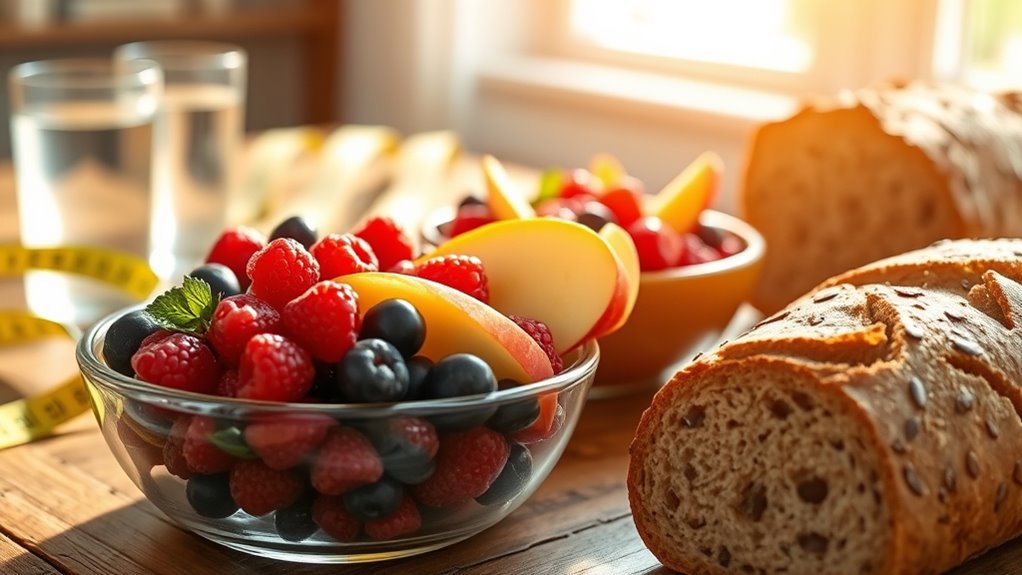
Eating a high-fiber diet can boost your energy levels by stabilizing blood sugar and improving digestion. It also helps lift your mood and build confidence as you experience better overall health. With these benefits, you’ll feel more motivated to stick with your weight control journey. Incorporating fiber-rich foods like fruits, vegetables, and whole grains can further enhance your digestive health and support your weight management efforts. A balanced intake of fiber can also influence your metabolic rate, making it easier to maintain a healthy weight. Additionally, understanding how fire safety regulations influence proper stove installation and maintenance can help create a safer environment for your home. Recognizing the importance of cheating in relationships can also remind us of the value of honesty and trust in our personal lives.
Enhanced Energy Levels
A high-fiber diet can considerably boost your energy levels by supporting both physiological processes and mental clarity. When you consume fiber, gut bacteria ferment it, producing short-chain fatty acids that supply energy to your colon and aid systemic metabolism. Although fiber’s direct caloric contribution is low, it helps reduce overall calorie intake by displacing higher-calorie foods and decreasing fat and protein digestibility. Fiber also promotes feelings of fullness, slowing gastric emptying and triggering satiety hormones like peptide YY and GLP-1, which curb hunger. Additionally, soluble fibers slow sugar absorption, preventing blood sugar spikes and crashes, providing sustained energy throughout the day. This steady energy release, combined with a healthy gut microbiome, supports your physical vitality and mental alertness, helping you stay focused and energized. Incorporating a variety of fiber-rich foods can further enhance these benefits and promote overall well-being, including digestive health. Moreover, a high-fiber diet can improve metabolic efficiency, as the positive effects on metabolism and overall health may reduce stress on bodily systems and contribute to better resilience and energy management.
Improved Mood and Confidence
Building on the energy benefits of a high-fiber diet, it also plays a significant role in enhancing your mood and boosting confidence. Studies show that higher fiber intake links to lower odds of depression—up to 49%—by reducing inflammation and supporting gut health. When your gut microbiome improves, it influences neurotransmitter production like serotonin and dopamine, which are vital for mood regulation. This connection through the gut-brain axis can help alleviate symptoms of depression and anxiety, making you feel more confident and balanced.
| Effect | Explanation |
|---|---|
| Mood Improvement | Better neurotransmitter balance |
| Confidence Boost | Reduced depression and anxiety symptoms |
| Gut-Brain Connection | Supports mental well-being through microbiome health |
Spotlight on Different Types of Fiber and Their Effectiveness
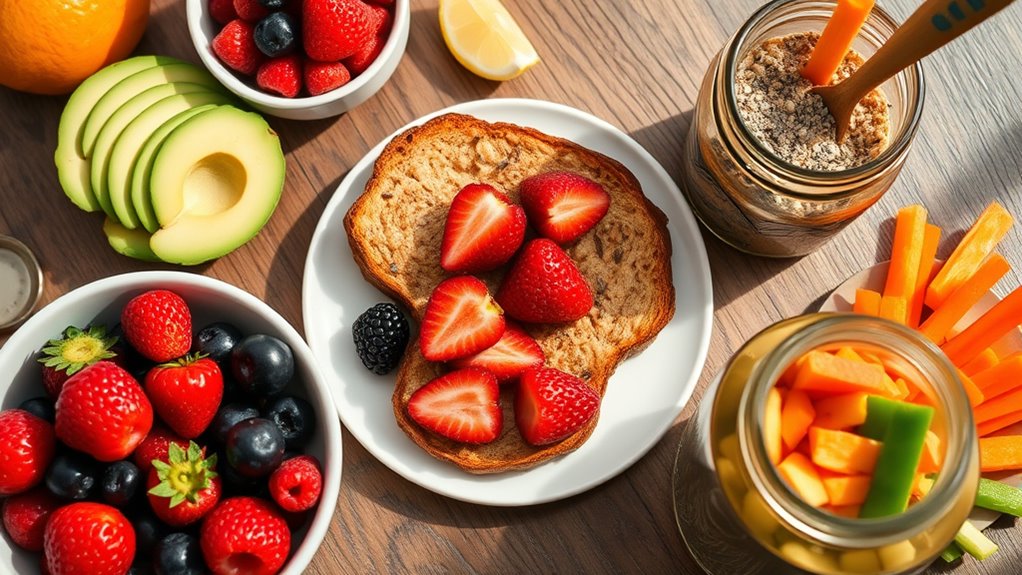
Have you ever wondered how different types of fiber work to support weight control and overall health? Soluble fiber slows digestion, helping you feel full longer and lowering blood sugar and cholesterol levels. You find it in oatmeal, apples, and beans. Insoluble fiber adds bulk to your stool, promoting regularity and preventing constipation—think whole grains and leafy greens. Specialized fibers like glucomannan support weight loss by increasing satiety, while beta-glucan improves insulin sensitivity, aiding metabolic health. Fructans feed gut bacteria but can cause digestive issues for some. Incorporating a variety of these fibers helps regulate blood sugar, lower cholesterol, and keep your digestion on track—all essential for effective weight control. By choosing diverse fiber sources, you enhance your overall health and support your weight management goals.
Building Long-Term Success With Fiber-Rich Eating Habits

Maintaining long-term weight loss hinges on consistent dietary habits, and incorporating more fiber-rich foods plays a crucial role in this process. Higher fiber intake independently correlates with greater weight loss, as those eating around 25 grams daily lose more weight than those consuming less. Adequate fiber also boosts dietary adherence, making it easier to stick with your plan. Over time, increasing fiber from sources like vegetables, fruits, beans, and whole grains supports sustainable weight management by reducing diet energy density. Consistent fiber consumption encourages healthier habits, keeping weight off beyond initial loss. Plus, fiber works synergistically with protein to promote satiety and lower calorie intake, enhancing your ability to maintain progress. Building these habits creates a solid foundation for long-term success.
Practical Ways to Increase Fiber Intake Daily
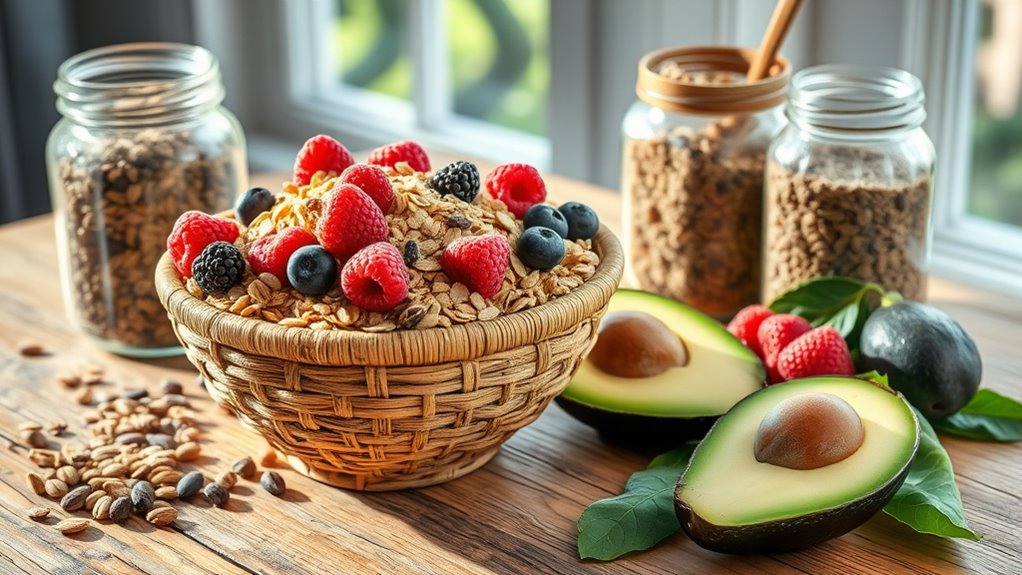
Increasing your daily fiber intake is a practical step toward long-term weight control and overall health. To boost fiber, start by adding high-fiber foods like fruits, vegetables, whole grains, nuts, and seeds to your meals. Gradually increase fiber to prevent digestive discomfort. Reading food labels helps you choose options with higher fiber content. Begin your day with oatmeal or whole-grain toast, and snack on fruits or nuts. Use cooking methods like steaming to retain fiber. Stay hydrated to support fiber’s movement through your digestive system. To illustrate, here’s a quick overview:
| Food Source | Examples | Fiber Content (per serving) |
|---|---|---|
| Whole grains | Brown rice, oats | 3-5 grams per cup |
| Fruits | Berries, apples | 3-8 grams per serving |
| Vegetables | Broccoli, carrots | 2-4 grams per cup |
| Legumes | Lentils, beans | 7-13 grams per half-cup |
| Nuts & Seeds | Almonds, chia seeds | 3-10 grams per ounce |
The Role of Fiber in Maintaining Lean Body Mass During Weight Loss
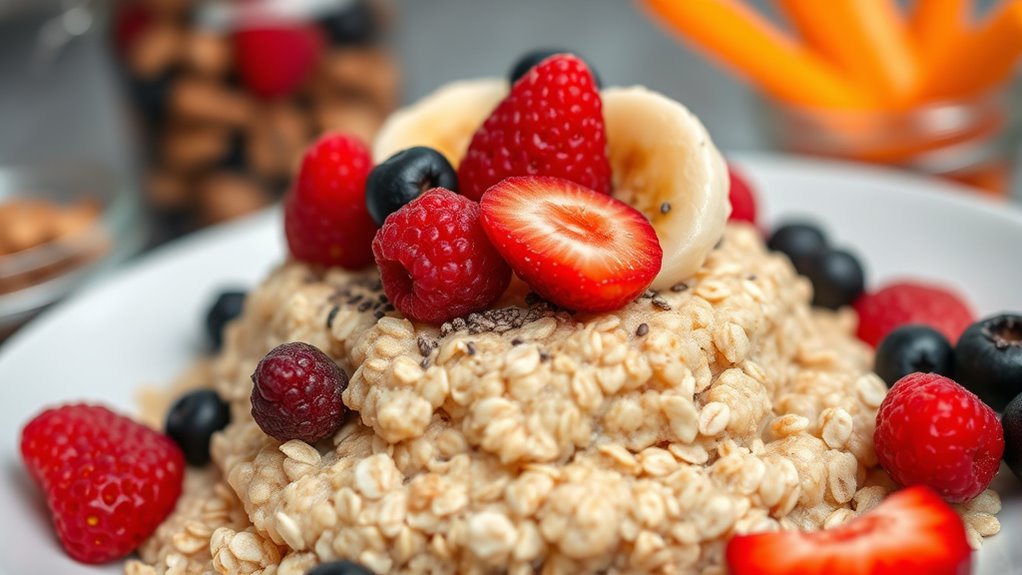
Dietary fiber plays a vital role in preserving lean body mass during weight loss by supporting muscle health and metabolic function. Higher fiber intake is linked to increased skeletal muscle mass and a lower BMI, helping you maintain a better body composition by reducing fat and increasing lean tissue. Fiber-rich diets improve nutrient density and overall dietary quality, aiding muscle preservation. Additionally, fiber boosts satiety, helping you feel fuller longer and reducing calorie intake, which is essential for weight loss. Combining fiber with adequate protein enhances muscle retention and supports fat loss. Furthermore, higher fiber intake is associated with improved metabolic health markers like blood sugar and insulin sensitivity, helping you sustain lean mass while promoting healthier body functions during your weight loss journey.
Unlocking Additional Health Benefits Through Fiber Consumption
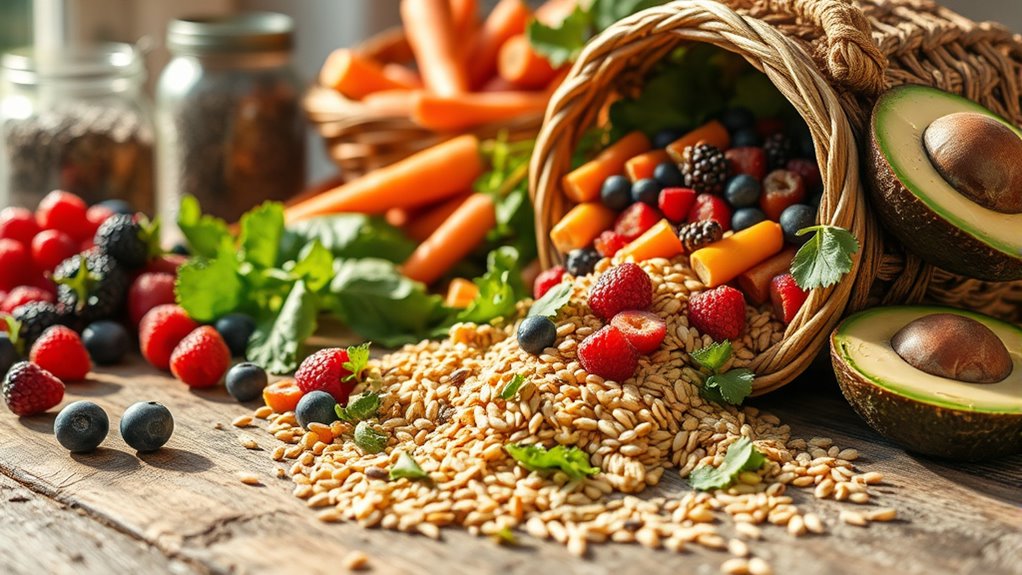
Consuming fiber offers a wide range of health benefits beyond weight control, substantially reducing the risk of chronic illnesses. By including more fiber in your diet, you can:
- Lower your risk of heart disease, stroke, type 2 diabetes, and colon cancer by up to 24%.
- Improve insulin sensitivity, helping your body better manage blood sugar levels.
- Support heart health by reducing the risk of death after a heart attack by 25%.
Fiber also promotes lung health by reducing inflammation, which can lower lung cancer risk. Additionally, a high-fiber diet can enhance respiratory function, reduce COPD risk, and even support better sleep and cognitive health. Incorporating more fiber benefits your entire well-being.
Frequently Asked Questions
Can Fiber Intake Replace Other Weight Loss Strategies Effectively?
You might wonder if fiber alone can replace other weight loss strategies. The truth is, it can’t. While increasing fiber helps with satiety and adherence, effective weight loss requires a combination of fiber intake, calorie control, and a balanced diet. Relying solely on fiber isn’t enough; you need to incorporate other strategies like portion management and physical activity for sustainable results.
Are Fiber Supplements as Beneficial as Whole Fiber-Rich Foods?
Think of fiber as a loyal guide on your weight loss journey. While supplements can be helpful, they’re like a map missing its landmarks—lacking the full landscape. Whole fiber-rich foods, on the other hand, offer a richer, more vibrant terrain, supporting digestion and satiety naturally. You benefit from diverse nutrients and gut health, making whole foods a more effective, sustainable choice for long-term weight management compared to supplements alone.
How Does Fiber Impact Gut Health During Weight Loss?
You might wonder how fiber impacts gut health during weight loss. Well, fiber ferments in your gut, producing beneficial compounds like SCFAs that support a healthy microbiome. It also promotes good bacteria growth, improves gut motility, and enhances satiety. By doing so, fiber helps maintain gut barrier integrity, reduces inflammation, and regulates blood sugar—all key factors in optimizing gut health and making your weight loss efforts more effective.
What Are the Best Fiber Sources for Sustained Weight Management?
Ever wonder what keeps your weight in check long-term? You should focus on high-fiber foods like lentils, black beans, and oats—they help you stay full and stabilize blood sugar. Fruits like pears and avocados, plus vegetables such as artichokes, also provide lasting energy. By choosing these fiber-rich options, you support steady weight management and curb unhealthy cravings. Isn’t that a simple, effective strategy for lasting health?
Does High Fiber Intake Affect Nutrient Absorption or Digestion?
High fiber intake can influence your nutrient absorption and digestion. It may slightly reduce how well your body absorbs minerals like calcium, magnesium, and phosphorus, especially with soluble fiber. Insoluble fiber speeds up digestion, which might decrease nutrient absorption overall. While fiber promotes gut health and regularity, eating too much can cause bloating and interfere with nutrient uptake, so balance is key for ideal digestion and nutrient absorption.
Conclusion
As you incorporate more fiber into your meals, it’s like planting seeds for a healthier future—you might not see the full bloom right away, but over time, your weight stays steady, your energy rises, and your cravings settle. Just like a winding river finds its path, fiber guides you toward better habits and long-term success. Keep going, and you’ll notice how these small changes create a surprisingly big impact on your well-being.
